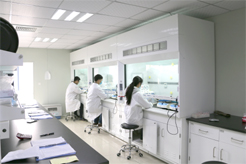The chemical synthesis of peptide
The chemical synthesis of peptide is a very special branch of organic synthesis. At present, there are two main methods: liquid-phase synthesis and solid-phase synthesis.
Liquid phase synthesis is a classical method of polypeptide synthesis, which adopt step-by-step synthesis or fragment condensation method. The step-by-step synthesis method usually starts from the C 'terminal amino acids of the chain, and repeatedly adds a single α - amino acid to the increasing amino acid components. As for fragment condensation, the target sequence is divided into several segments reasonably, and then each segment is synthesized step by step. Finally each segment is condensed according to the sequence requirements.
The advantages of liquid phase synthesis are that the intermediates can be purified in every step, and can obtain the physical and chemical constants of the intermediates .Its good at avoiding the absence of amino acids .buy are time-consuming and relative high cost.
The solid-phase synthesis is to form of covalent bond by connecting the carboxyl group of the first amino acid of the target peptide with the solid-phase carrier (resin) , then take the amino group of the amino acid as the starting point of synthesis ,to form peptide bond by acylate with the carboxyl group of the adjacent amino acid.
Liquid phase synthesis and solid phase synthesis have their own advantages and disadvantages, so we should choose the suitable process according to the actual needs of synthesis. Generally speaking liquid phase synthesis is more suitable for short peptide synthesis and solid phase synthesis is more suitable for medium and long peptide synthesis. Of course, the two methods can also be used in combination, for example, the short peptide fragment can be synthesized by liquid-phase method, and then the fragment can be applied to solid-phase synthesis.

Both the liquid phase synthesis and the solid phase synthesis are based on the designed amino acid sequence, and the target molecules are obtained by the way of directional formation of amide bond.Theoretically speaking, this is not complicated, but there are still many factors to consider in the implementation.Carboxylic acids form amide bonds with amines by first converting the carboxyl group into an active carboxyl derivative (such as acyl chloride or anhydrides) and then reacting with amines, or adding a condensation agent to the reaction system
However, the formation of amide bonds between amino acids is much more complicated, because each amino acid contains both amino and carboxyl groups. If the carboxyl group of an amino acid is activated, it can react with the amino group of the same or another amino acid molecule; if several amino acids are mixed together and a condensation agent is added, only a mixture of peptides with different amino acid sequences can be obtained. Therefore, in the research of peptide synthesis, we should not only pay attention to activation method and coupling method, but also need to the choose the appropriate protection / deprotection strategy.
In the process of peptide synthesis, some heteropeptides with similar structure to the target peptide will be produced, such as non enantiomers due to amino acid racemization, missing peptides due to some amino acids not connected, broken peptides due to peptide bond breaking, etc. Therefore, it is necessary to select reliable separation and purification methods to make the purity of peptide meet the requirements. The purification of peptide drugs usually uses chromatography, but in some cases, the common purification methods (such as recrystallization) in organic synthesis may also be applicable.
For more informations about peptide synthesis,please visit our website:www.omizzur.com
Copyright © 2020 Omizzur Inc | Terms & Conditions | Privacy Notice | Sitemap